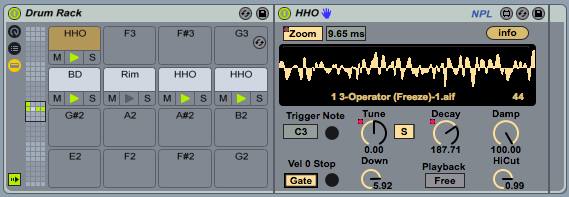Cue Huey Lewis and the News singing “Back in Time,” because we’re going back to the 80s. And where we’re going, we don’t need … stereo.
Robert Henke (who has of late mostly shed the Monolake moniker) has a brilliant new Max for Live drum machine that borrows some of the limitations of vintage 80s drum machines. There’s a particular nod to drum machine pioneer Roger Linn (credited as such). But this isn’t just 80s nostalgia. MicroDrum’s restrictions, sound, and use of ideas from that hardware can bring new creative possibilities.
Features:
- Zoom in on samples to 10 ms and truncate start point
- Tune up and down, optionally quantized to semitone
- Basic decay and anti-aliasing filter
- Use lower sample rates with parameter control
- Bit resolution
- MIDI triggering
- Drag-and-drop samples
- Mono audio
And still more vintage features: “The internal 8 bit process of MicroDrum emulates a logarithmic DAC stage and a 24dB anti aliasing filter, so it sounds as good as it can with 8 bit. Still it produces a lot of potentially nice noise in the higher frequencies.”
Then there are more clever implementation details, inspired by hardware solutions past:
… a special filter has been added that dampens the high frequencies above 500 Hz faster than the normal decay rate (Damp). This allows to get low drums with a punchy attack but less noise afterwards.
When using a sample for a hi-hat and it is triggered repeatedly, it becomes very obvious that it is static. To overcome this, Roger Linn used a looping hi-hat sample and superimposed only the volume envelope. The loop point was not reset at sample start, so each time you triggered a hi-hat you did hear a slightly different sound. MicroDrum has the same playback feature (Free). It probably only makes sense for static looping sounds.
Part of what’s remarkable that Robert got this release out is this weekend that he was busy in Amsterdam both performing and talking about the latest iteration of his Lumière audiovisual show (live electronic music, live choreographed laser geometries). In a pre-concert talk, he told us that part of what he admired about the lasers was having mechanical limitations – boundaries that inspired creativity, versus being spoiled by the seemingly limitless potential of a computer. Of course, what you can do with software is impose your own rules and limitations, which is precisely what this patch does.
Technological limitations aside, though – he was patching this in the middle of the Amsterdam performance and talks. Impressive.
Have a go. The license allows you to modify your own versions and share them – and make any music with the patch you like – so long as you don’t try to make a commercial product out of the patch. (Effetively, it’s a Creative Commons ShareAlike license, that is.)
http://www.roberthenke.com/technology/microdrum.html
And, sorry, having opened that can of worms, here we go:
